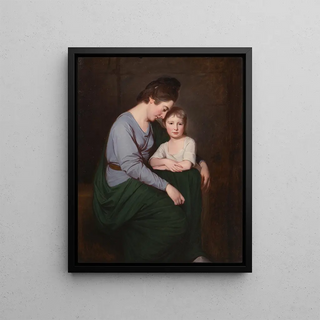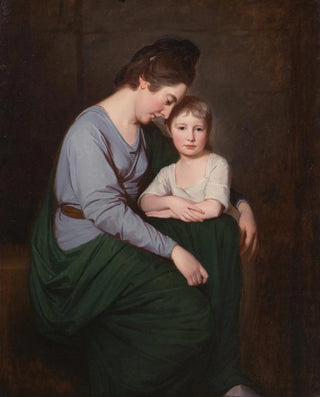Art print | Ann Wilson with her daughter Sybil - George Romney


View from behind

Frame (optional)
Art print Ann Wilson with her daughter Sybil - George Romney – Captivating introduction
In the fascinating universe of art, some works manage to transcend time and capture the essence of human relationships with such intensity that they become essential references. "Ann Wilson with her daughter Sybil" by George Romney is one of these creations. Created in the 18th century, this painting evokes not only the tenderness of a maternal bond but also a frozen moment that still resonates today. The depiction of this mother and her daughter, enveloped in an atmosphere of softness and intimacy, invites the viewer to immerse themselves in a world where family love is celebrated with rare delicacy. This painting, both simple and complex, speaks to us of the beauty of relationships and how they can be immortalized by an artist's brush.
Style and uniqueness of the work
George Romney's style is distinguished by its elegance and ability to capture the emotional nuances of his subjects. In "Ann Wilson with her daughter Sybil," the artist uses a palette of soft colors and subtle play of light to create a soothing atmosphere. The faces of the two figures, imbued with serenity, testify to a deep connection that goes beyond mere representation. The composition is carefully balanced, each element arranged to direct the gaze toward the main characters. The drapery of the clothing, of remarkable finesse, adds a tactile dimension to the work, while the background, though discreet, contributes to the overall harmony. This attention to detail and the humanity of the figures make this work a perfect example of 18th-century family portraiture, where every gaze and gesture tell a story.
The artist and his influence
George Romney, born in 1734, is one of the most emblematic painters of his time, recognized for his ability to combine realism and idealization. Influenced by masters such as Reynolds and Gainsborough, he developed a style that is uniquely his own, blending a keen sense of observation with romantic sensitivity. His career, marked by a series of portraits of prominent figures of his era, helped shape the British artistic landscape. Romney was also a pioneer in

Matte finish

View from behind

Frame (optional)
Art print Ann Wilson with her daughter Sybil - George Romney – Captivating introduction
In the fascinating universe of art, some works manage to transcend time and capture the essence of human relationships with such intensity that they become essential references. "Ann Wilson with her daughter Sybil" by George Romney is one of these creations. Created in the 18th century, this painting evokes not only the tenderness of a maternal bond but also a frozen moment that still resonates today. The depiction of this mother and her daughter, enveloped in an atmosphere of softness and intimacy, invites the viewer to immerse themselves in a world where family love is celebrated with rare delicacy. This painting, both simple and complex, speaks to us of the beauty of relationships and how they can be immortalized by an artist's brush.
Style and uniqueness of the work
George Romney's style is distinguished by its elegance and ability to capture the emotional nuances of his subjects. In "Ann Wilson with her daughter Sybil," the artist uses a palette of soft colors and subtle play of light to create a soothing atmosphere. The faces of the two figures, imbued with serenity, testify to a deep connection that goes beyond mere representation. The composition is carefully balanced, each element arranged to direct the gaze toward the main characters. The drapery of the clothing, of remarkable finesse, adds a tactile dimension to the work, while the background, though discreet, contributes to the overall harmony. This attention to detail and the humanity of the figures make this work a perfect example of 18th-century family portraiture, where every gaze and gesture tell a story.
The artist and his influence
George Romney, born in 1734, is one of the most emblematic painters of his time, recognized for his ability to combine realism and idealization. Influenced by masters such as Reynolds and Gainsborough, he developed a style that is uniquely his own, blending a keen sense of observation with romantic sensitivity. His career, marked by a series of portraits of prominent figures of his era, helped shape the British artistic landscape. Romney was also a pioneer in






